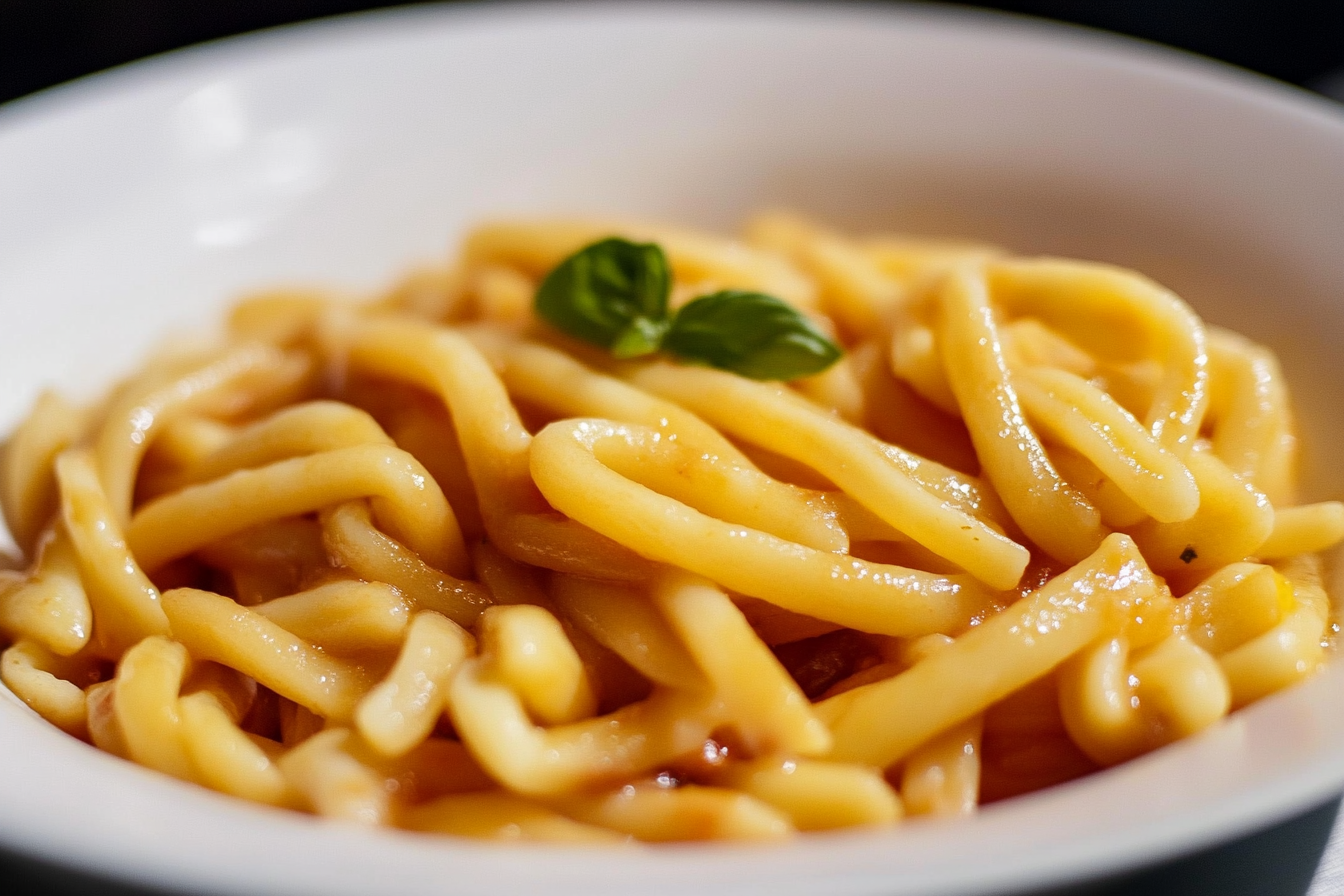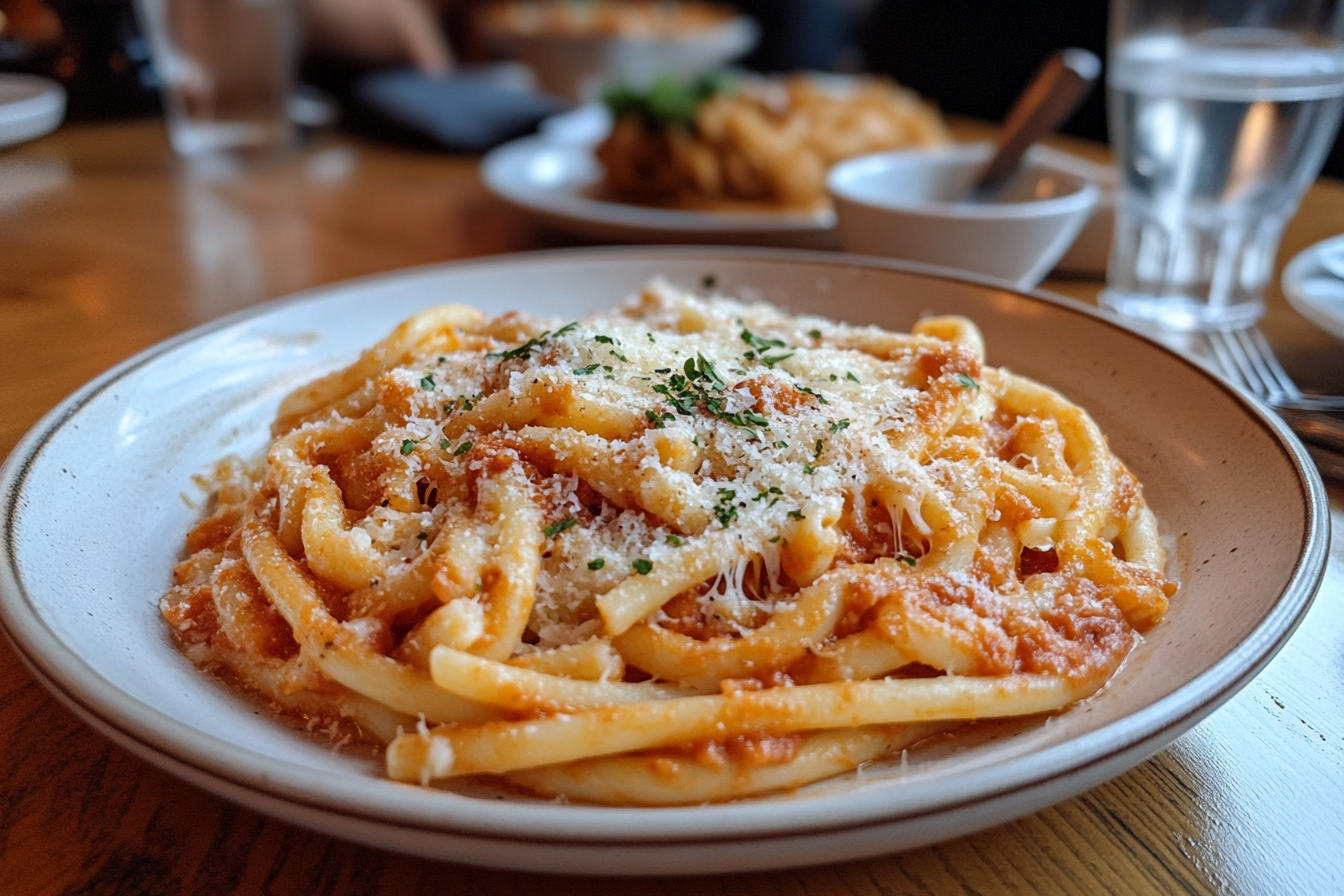When we think of Italian pasta, several shapes and varieties come to mind spaghetti, penne, fettuccine, and more. However, nestled within Italy’s culinary landscape is Strozzapreti, a twisted, hand-rolled pasta that boasts rich cultural significance and culinary versatility. Whether you’re a pasta connoisseur or a newcomer, Strozzapreti is worth exploring.
This article will walk you through the fascinating history of Strozzapreti, its many forms and uses, its place in Italian culture, and, most importantly, how you can make and enjoy it at home with a variety of recipes. We’ll also look into the nutritional benefits and how Strozzapreti fits into modern dietary trends.
What is Strozzapreti?
Strozzapreti is a type of hand-rolled pasta known for its twisted shape. Traditionally made from flour and water, or sometimes with the addition of eggs, this pasta is famous for its ability to hold onto chunky, hearty sauces. The word “Strozzapreti” literally means “priest stranglers,” a name steeped in legend and cultural folklore.
History of Strozzapreti
The history of Strozzapreti is as fascinating as its name. It is believed that the pasta originated in the regions of Emilia-Romagna, Tuscany, Marche, and Umbria during the Middle Ages. Some stories suggest that the pasta was prepared by housewives who, frustrated by the excessive indulgence of local priests, hoped that they might choke on the food. While this tale is colorful, others suggest that the name comes from how quickly the clergy devoured the pasta.
Strozzapreti Through the Ages
- Middle Ages: Initially popular among peasants due to its simplicity, Strozzapreti required few ingredients, making it accessible to even the poorest of families.
- Renaissance Era: As Italian cuisine evolved, Strozzapreti began to take on a more significant role at the dinner table, particularly during celebrations and religious holidays.
- Modern Italian Cuisine: Today, Strozzapreti has retained its place in Italian kitchens, being featured in both traditional dishes and innovative modern recipes.
Strozzapreti’s enduring appeal lies in its simplicity. While other pastas may boast complex shapes or elaborate production processes, Strozzapreti is about the art of handcrafting and transforming basic ingredients into something exceptional.

The Cultural Significance of Strozzapreti
Regional Differences
Though Strozzapreti is most closely associated with Emilia-Romagna, it is also popular in neighboring regions like Tuscany and Umbria. Each area has its own variations in ingredients and techniques. For example, in Tuscany, housewives traditionally added eggs to the dough, while in Emilia-Romagna, it was common to omit them, relying solely on flour and water.
Strozzapreti has a place in the hearts of Italian families, especially when served at large gatherings or special events. In many households, pasta-making is a skill passed down through generations, ensuring that this traditional dish remains alive in kitchens across the country.
Making Strozzapreti at Home
One of the most satisfying aspects of Strozzapreti is that it can be easily made at home. The dough requires just a few ingredients, and the shaping process is fun and therapeutic.
Ingredients for Homemade Strozzapreti
- 2 cups of all-purpose flour (or semolina flour for a firmer texture)
- ½ cup of water (adjust depending on the dough’s consistency)
- Optional: 1 egg (for a richer dough)
Step-by-Step Guide to Preparing Strozzapreti
- Prepare the Dough: In a large bowl, combine the flour and water (add the egg if using). Mix the ingredients together until they form a dough.
- Knead the Dough: Transfer the dough to a lightly floured surface and knead for about 10 minutes. The dough should become smooth and elastic.
- Rest the Dough: Wrap the dough in plastic wrap and let it rest for 30 minutes. This step allows the gluten to relax and makes the dough easier to roll out.
- Shape the Pasta: After the dough has rested, roll it out into thin ropes. Cut the ropes into small pieces (about 3 inches long), then twist them by hand to create the signature Strozzapreti shape.
- Cook the Pasta: Bring a large pot of salted water to a boil. Cook the Strozzapreti for about 3–4 minutes, or until it floats to the surface.
Homemade Strozzapreti can be enjoyed immediately or dried for later use. Drying the pasta slightly before cooking allows it to develop a firmer texture, which some people prefer when pairing it with hearty sauces.
Pairing Strozzapreti with Sauces
One of Strozzapreti’s greatest strengths is its ability to hold sauces. The twists in the pasta provide plenty of surface area for sauces to cling to, making it an ideal choice for thicker, chunkier sauces. Below are some classic and modern pairings:
Traditional Sauces
- Strozzapreti alla Bolognese: This hearty meat sauce, originating from the Emilia-Romagna region, is the perfect complement to Strozzapreti. The rich, slow-cooked beef sauce clings to the pasta, ensuring every bite is packed with flavor.
- Strozzapreti alla Puttanesca: This zesty, Mediterranean-style sauce made with tomatoes, olives, capers, and anchovies brings a burst of salty, tangy flavors that elevate the simplicity of Strozzapreti.
- Strozzapreti with Sausage and Broccolini: Combining Italian sausage, garlic, and broccolini, this dish is full of bold flavors and works beautifully with the chewy texture of the pasta.
Modern Sauces
- Strozzapreti with Creamy Garlic and Mushrooms: A contemporary take, this sauce features a combination of sautéed mushrooms, garlic, and cream, delivering a rich yet delicate flavor that complements the pasta’s texture.
- Strozzapreti with Pesto: For a fresh, herbaceous option, toss your pasta with a pesto made from basil, garlic, pine nuts, Parmesan cheese, and olive oil. The pesto coats each twist of the Strozzapreti, adding a vibrant, flavorful punch to each bite.
In addition to these sauces, consider adding seasonal ingredients like roasted vegetables or freshly grated cheese to create your own unique dishes. For more ideas, take inspiration from this homemade chickpea pasta recipe to explore alternatives to traditional wheat-based pasta.
Health Benefits and Nutritional Information of Strozzapreti
While pasta is often considered a comfort food, Strozzapreti can be part of a balanced diet. By choosing whole-grain flour or gluten-free alternatives, you can increase the nutritional value of the dish without sacrificing flavor.
Nutritional Profile (per 100g serving)
- Calories: 300
- Carbohydrates: 60g
- Protein: 10g
- Fat: 2g
Healthier Variations
- Whole Grain Strozzapreti: Made with whole wheat flour, this version of Strozzapreti offers more fiber and nutrients than its white flour counterpart.
- Gluten-Free Strozzapreti: For those with gluten sensitivities, Strozzapreti can be made with a blend of gluten-free flours such as rice or chickpea flour, providing a nutritious alternative.
Incorporating vegetables into your Strozzapreti dishes, such as adding broccoli, spinach, or zucchini, can also enhance the dish’s nutritional value. Pairing the pasta with lean proteins like chicken or turkey sausage further boosts its health benefits. For those with gluten sensitivities, Strozzapreti can be made with gluten-free flours such as chickpea or rice flour. Try this gluten-free pasta recipe to create a delicious alternative.

Strozzapreti Recipes for Every Occasion
No matter the occasion, Strozzapreti can be tailored to suit your needs. Here are several recipes that range from quick weeknight meals to elaborate dishes perfect for entertaining.
Quick Weeknight Strozzapreti with Tomato and Basil
For a simple yet satisfying dish, this Strozzapreti recipe combines fresh tomatoes, basil, and garlic to create a light, flavorful pasta that can be made in under 30 minutes.
Ingredients:
- 500g Strozzapreti
- 2 cups fresh cherry tomatoes, halved
- 3 garlic cloves, minced
- ¼ cup fresh basil leaves, chopped
- Olive oil, salt, and pepper to taste
Instructions:
- Cook the Strozzapreti in salted boiling water for 3–4 minutes or until al dente.
- In a large pan, heat olive oil over medium heat. Add the minced garlic and sauté until fragrant.
- Add the halved cherry tomatoes and cook until softened. Season with salt and pepper.
- Toss the cooked Strozzapreti with the tomato mixture, stirring in the fresh basil before serving.
This simple dish is perfect for a quick meal and highlights the pasta’s ability to absorb the fresh, bright flavors of the ingredients.
Strozzapreti for Special Occasions
For more formal meals, consider pairing Strozzapreti with decadent sauces and ingredients like lobster, truffle, or premium meats. The pasta’s unique texture elevates even the most luxurious ingredients.
Lobster Strozzapreti with White Wine Cream Sauce
This indulgent dish combines sweet lobster meat with a rich white wine cream sauce. The twists of the Strozzapreti hold the sauce beautifully, making every bite a luxurious experience.
Ingredients:
- 500g Strozzapreti
- 2 lobster tails, cooked and chopped
- 1 cup heavy cream
- ½ cup white wine
- 2 garlic cloves, minced
- 1 shallot, finely diced
- ¼ cup Parmesan cheese, grated
- Fresh parsley for garnish
Instructions:
- Cook the Strozzapreti in salted boiling water until al dente.
- In a large skillet, sauté the garlic and shallots in olive oil until fragrant. Add the white wine and cook until reduced by half.
- Stir in the heavy cream and Parmesan, allowing the sauce to thicken.
- Add the chopped lobster meat and cooked Strozzapreti to the pan, tossing to coat evenly.
- Garnish with fresh parsley and additional Parmesan before serving.
Strozzapreti and Modern Dietary Trends
As diets evolve, so too does pasta. Strozzapreti has adapted to modern preferences, with recipes catering to gluten-free, low-carb, and plant-based diets.
- Vegan Strozzapreti: Replace eggs with flaxseed meal and use olive oil-based sauces to keep the dish plant-based.
- Low-Carb Strozzapreti: Use alternative flours such as almond or coconut flour to create a lower-carb version of this traditional pasta.
Conclusion
Strozzapreti is more than just a pasta; it’s a symbol of Italian tradition, family, and the art of handmade food. Whether you’re enjoying it in a simple tomato sauce or a decadent lobster cream sauce, this pasta will bring a touch of Italy to your table. With its rich history, cultural significance, and culinary versatility, Strozzapreti deserves a place in your kitchen.
For more pasta ideas and culinary inspiration, explore recipes like this Capellini or Pepper Jack Cheese Guide to enhance your pasta knowledge.

